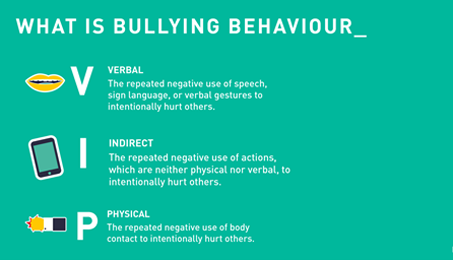School should be a happy, safe, inclusive environment, where all students thrive and fulfil their potential. We are proud of our school and our students and want the best for them. As a team we work hard to make the school a welcoming place where bullying is a rare occurrence and that students feel confident to seek support should they need to.
What is Bullying?
There is no legal definition of bullying. However, it is often defined as “repeated negative behaviour that is intended to make others feel upset, uncomfortable or unsafe” (Diana award) and the reasons for bullying are often related to differences between people, such as gender, race, sexual orientation or gender orientation. However, this list is not exhaustive and often the real reason is for bullying is related to how the bully feels about themself.

Aims
Our message to those who bully is very clear – it is not acceptable. The anti-bullying ambassadors have drawn up a charter which they feel expresses the school’s stance on bullying and reminds students of how we would want our students to behave:
-
Treat each other as you would wish to be treated
-
Use social networks appropriately to spread positivity
-
Use appropriate language, be inclusive
-
Do not tolerate discrimination of any kind
-
Stand up against bullying – report it to a trusted adult
-
Don’t suffer in silence – speak to the ambassadors
-
This is reinforced by clear sanctions for any student who has been involved in bullying behaviour. These can range from a formal verbal warning, all the way up to a fixed term exclusion, and will depend upon the frequency and severity of the bullying behaviour.
Team
DSL 
Clarissa Ourabi
Safeguarding Lead

Rachel Laughlin
Anti-Bullying Co-ordinator

Rachel Wiggins
SENDCO

Louise Monk
Pastoral Support Worker

Emma Parry
Pastoral Support Worker

Lisa Tanser
School Nurse
In the Curriculum
As a school we take seriously any reports of behaviour that is not in-line with the school behaviour policy. Students through the assembly program students are clear of what the school expectations are and what the sanctions and education is when behaviour falls below these standards. We are a school of over 1,600 individuals and each and every student should be valued for this uniqueness.
Students are taught about the importance of been a model citizen in and out of school and respect and tolerance for each other. They are also given the skills to be able to cope with relationship/friendship breakdown and how to seek support when they are concerned about a friendship.
As part of the curriculum we specifically cover the following;
-
Healthy relationship and friendships
-
Online risks and social media
-
The rule of democracy and equality
-
The impact of discrimination and how to react to circumstances where this may happen
-
Upstander versus Bystander
-
The rule of tolerance and respect
-
Sexual harassment and violence
-
Consent
-
Use of misogynistic language and the impact it can have on us
Policies
Student Leadership
Anti-Bullying Ambassadors
The Role of the anti-Bullying Ambassadors
Anti-Bullying Ambassadors are trained, passionate young people who will stand up to bullying behaviour and believe they can change things for the better. They believe that bullying behaviour is not acceptable and should not be part of everyday life at school. They supportothers and are upstanders against bullying behaviour and a support network for their peers. They stand to shape attitudes and change behaviours. They are the pillar of support, look out for others and are a strong voice for the school community.

What do the anti-bullying ambassadors do?
-
Create a student friendly Anti-bullying policy
-
Update the information on Anti-bullying in school planners
-
Create student friendly guides to staying safe, how to tackle and report bulling through displays around school
-
Encourage the use of reporting systems in the school such as TootToot
-
Attend external training sessions that can support our aims in school
-
Promote online safety, kindness, diversity and respect in school
-
Provide extra support through mentoring schemes to people who have experienced bullying
-
Supervise Safe Spaces and the Welfare Hub in school
-
Support CPD sessions to staff on Anti-bullying
-
Work with other Student Leader groups to be role models to empower, encourage and engage the young people in school to tackle bullying
-
Work with the school community to promote Anti-bullying
External Information/Support
-
www.childline.org.uk - get help and advice about a wide range of issues, talk to a counsellor online, send ChildLine an email or post on the message boards.
-
www.cybermentors.org.uk - A social networking place where you can find out about bullying and what you can do about it and also talk to mentors your own age.
-
www.bullying.co.uk - bullying at work, cyberbullying, and find out how you can deal with it from leading bullying organisation Bullying UK.
-
www.need2know.co.uk/beatbullying/ - Helpful articles on how to deal with issues around bullying.
-
www.antibullying.net/ - The Anti-Bullying Network is an independent operation with the following objectives: •to support anti-bullying work in schools; •to provide a free website; •and to offer an anti-bullying service which will include the provision of training, publications and consultancy services.
-
www.ypas.org.uk - committed to supporting young people aged 10 to 25 years in a safe environment with a primary focus on respect and acceptance
-
www.education-otherwise.org - a UK charity offering information and support to home educating families.
-
www.cruelatschool.co.uk - website aimed at other families whose children are or have been bullied at school.
-
www.cctvcameraworld.com/what-is-cyberbullying-and-how-to-prevent-it.html